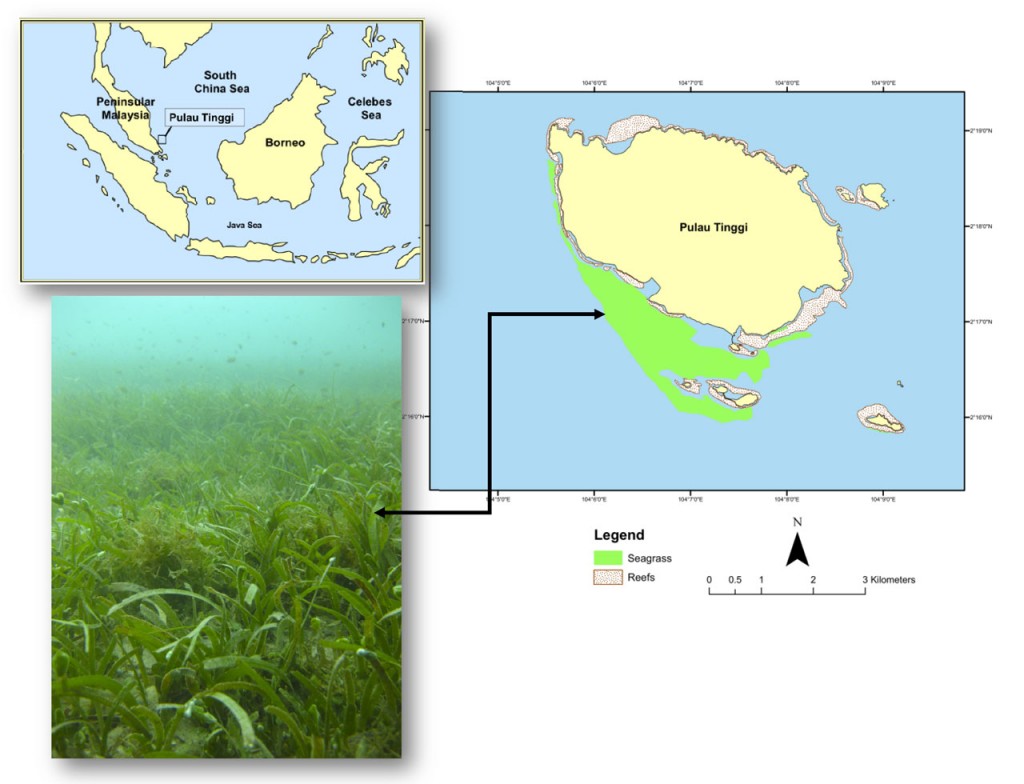Every fortnight we feature a seagrass meadow from around the world. This week, Jillian Ooi writes about Pulau Tinggi, an island off the east coast of Peninsular Malaysia. Jillian has just recently completed her PhD at the University of Western Australia in Perth and is now based at the University of Malaya, in Kuala Lumpur.When she’s not grass-watching, she plays the gamelan with Rhythm in Bronze, a gong chime ensemble in Malaysia.
—————————————–
By Jillian Ooi
Photos courtesy of Affendi Yang Amri and Serina Rahman.
The first time I ventured into the seagrass meadows of Pulau Tinggi was in 2005. Back then, we were tracking the movement of dugongs in the area, but I became absolutely enchanted by the meadow itself.
It was like a magical garden filled with wonderful critters everywhere I looked. Golden sea cucumbers, knobbly sea stars, sea hares, green turtles, black tip sharks, and my favourite – the gobiid fishes and their associated burrowing shrimps, are some of the reasons I jumped at the chance of going back there for my PhD in seagrass biogeography three years later.
Pulau Tinggi is a marine park island located 12 km off the southeast coast of Peninsular Malaysia. In Malay, tinggi means ‘tall’. This island was named for its 600 m high peak shaped like a Mandarin’s hat. In olden days, Pulau Tinggi was a stopover point for spice traders. Today, it is sparsely inhabited and relatively undeveloped (i.e. no large luxury resorts as of 2010, although I hear plans are underway for some).

Pulau Tinggi, located off the southeast coast of Peninsular Malaysia, has a rich seagrass system in the forereef zone.

Our trusty boat, Gloria, skippered by Eddie, a local villager. In the background is the high peak of Pulau Tinggi.
Its villagers rely on home-stay programmes targeted mainly at recreational fishermen. Its seagrass meadows are really something else. Mixed stands of Halophila ovalis, Halophila decipiens, Halophila minor, Halophila spinulosa, Halodule uninervis, Syringodium isoetifolium and Cymodocea serrulata grow in the area between the coral reef and sea. These forereef meadows are interesting because they comprise mainly small, fast-growing species growing in deeper waters and on unconsolidated sandy substrate. In most other Southeast Asian meadows, back reef meadows dominated by Enhalus acoroides and Thalassia hemprichii are the better known systems (Ooi et al 2011, Estuarine, Coastal and Shelf Science).
We found numerous dugong feeding trails, and frequently sighted dugongs surfacing around our boat. As a result, colleagues working on the Dugong dugon are now starting to turn their attention towards the Pulau Tinggi group of islands. Burrowing shrimp mounds are also common, and I was finding new mounds created almost daily in my study plots. Does this type of small-scale sediment burial kill the seagrasses? Yes it does, if a mound stays intact for at least 4 weeks. However, burial has more of an effect on small and ‘selfish’ species such as Halophila ovalis and Halodule uninervis (Ooi et al 2011, Continental Shelf Research). In comparison, larger species such as Cymodocea serrulata and Syringodium isoetifolium appear to survive burial better because they transfer resources to buried shoots.
So far, the main seagrass meadows on the south-western side of Pulau Tinggi have been mapped using tow underwater video in 2009. Plans are in place to set up permanent monitoring sites in the coral reefs and seagrass meadows to collect long-term data. Together with collaborators at the University of Western Australia, we are also continuing to develop models to understand the distribution patterns of the main seagrass species in relation to sediment properties.
The underwater world is not the only reason for my fond memories of Pulau Tinggi. We lodged with a local family who took us out to sea, filled our dive tanks, let us watch the World Cup on their TV, and welcomed us at a family member’s wedding. 
Research facilities were basic, but I managed by converting the family’s grocery shop into a makeshift lab. The matriarch, Maksu, kept our spirits up by plying us with freshly-caught fish and sambal belachan, chilli donuts, fried bananas, fresh coconut juice, pressed rice topped with a thick chilli peanut sauce, durian porridge, and keropok lekor (something like a fish sausage is how I would describe it). On days off, we’d trek to our private waterfall to soothe our aching muscles and visit the resident Malayan soft-shelled turtle there.
But what does the future hold for the seagrasses in Pulau Tinggi? There are plans for a luxury resort, a jetty, and a kelong (a traditional fishing platform on stilts) in the vicinity of the meadow I studied. Thus, changes are inevitable. As development extends gradually across Pulau Tinggi and its surrounding islands, anthropogenic impacts on seagrasses will become evident. For this reason, it is important that our work here continues.



